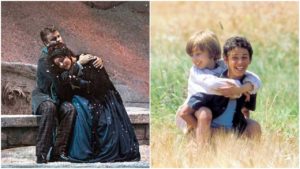
Opera Meets Film: ‘Io Non Ho Paura’ As A Retelling of Puccini’s ‘La Bohème’
By David Salazar“Opera Meets Film” is a feature dedicated to exploring the way that opera has been employed in cinema. We will select a section or a film in its entirety, highlighting the impact that utilizing the operatic form or sections from an opera can alter our perception of a film that we are viewing. This week’s installment features “Io non ho paura.”
“Che gelida manina” is one of the great opera arias of all time, pitting it cold imagery of Mimì’s frozen hand against the warmest of melodies, one that will flourish into the most passionate and glorious of romances in all of opera. It also represents the opera as a whole, for amidst the beauty of love and youth, is the cold and ugly truth of death.
The aforementioned opera aria enters the picture early in the film before Michele, the 10-year-old protagonist of “Io Non Ho Paura (“I’m Not Scared),” really has any understanding of what is going on. He is walking by a local pig farmer when he hears Puccini’s famed aria playing over some speakers. As the music commences, the audience’s focus is on Michele so the initial association is with him. But then suddenly we cut to images of pigs fighting over food and eventually the farmer, vulgarly clad and screaming at the young boy to mind his business; all the while, the glorious music continues, creating a tremendous dissonance within the story for Michele, but also for the viewer’s experience. This dissonance between beauty and ugliness will permeate the film visually and thematically.
Moreover, one can see the aria itself as shining a light on the film as a loose adaptation of the opera itself.
Michele is entering his adolescent years and much of the film emphasizes sequences in which he and his friends play in the wheat fields under the warm sun. A string quartet, full of lush and gloriously rich melodic invention, plays throughout the film, creating a sense of a movie about youthful exuberance. But at its heart, it is also about the evil and corruption of adulthood as Michele’s father and his friends kidnap another innocent boy, Filippo, to obtain a ransom from a wealthy family.
Michele comes to the realization of this event and much of his story revolves around his confusion about how to act. Should he go with his gut and save Filippo? Or should he trust that his father is doing the right thing?
A closer reading of the film and “La Bohème,” in the context of “Che gelida manina’s” inclusion in the former, suggests a close similarity between the two. While “La Bohème” is a love story, it is also about two people coming together in both beautiful and difficult times. This is exactly what “Io Non Ho Paura” represents in the context of Michele and Filippo’s burgeoning friendship. While Michele is initially afraid of Filippo, he does have his own “Gelida manina” moment when he helps the young boy to open his eyes and see the light. Like Rodolfo, who does not know of Mimì’s condition, Michele doesn’t quite understand why Filippo is in the hole. He doesn’t really think much of it.
In a latter sequence, the film works to develop their friendship, showing them out in the world enjoying the fields around them; this is much in the vein of Rodolfo and Mimì’s relationship where their love, especially in Act two, allows Mimì an outlet away from her cruel destiny. However, eventually reality settles in and both Rodolfo and Michele are forced to face the reality that their lover / friend will die and there is nothing they can do. Mimì will be ravaged by her disease and Filippo will be killed by the adults.
That’s where we return to the aria, with its intense foreshadowing, the effect intertextual. Those who know Puccini’s opera, know that that first touch of Mimì’s hand and the reference to its coldness is the first hint of her fate. The opera’s gloriously energetic second act will eventually lead to nothing more than Rodolfo crying out as he holds the dead Mimì in his hands. In the context of this film, the appearance of this very aria, and those specific words, foreshadows the film’s own tragic (?) conclusion.
Michele ultimately saves Filippo from certain death, but winds up shot by his own father. While the audience never really learns whether Michele lives or dies as the credits roll, the simple fact that he was shot by his own father is the film’s ultimately tragedy. If he dies, his father will have to carry that burden of having taken the life of his only son. If he survives, their relationship will never be the same.
But the film, while acknowledging the tragedy of Michele and his own familial situation, refuses to leave on a completely grim outlook. The film’s final image, of Michele and Filippo reaching out their hands to touch one another, brings us right back to the aria, leaving the audience with the lingering question of what is to come. Will Filippo touch a cold hand of a now dead loved one? Or will their connection be strengthened if Michele lives on? In the context of Puccini’s “Bohème,” “Io Non Ho Paura” enables the audience a chance at imagining a more hopeful ending in which the purest of friendships gets another chance.
Categories
Opera Meets Film

